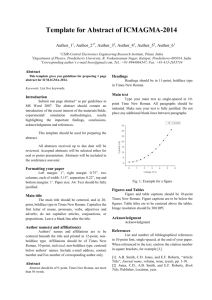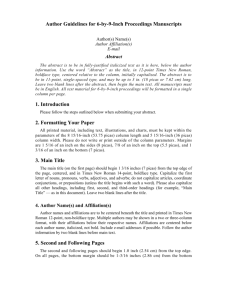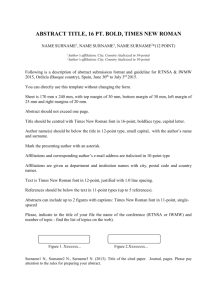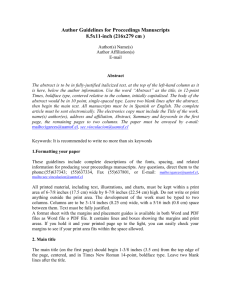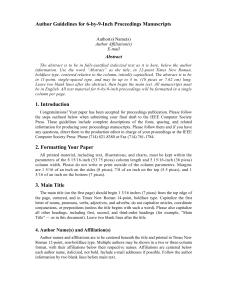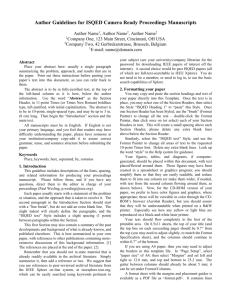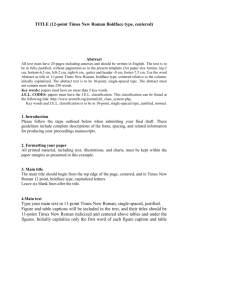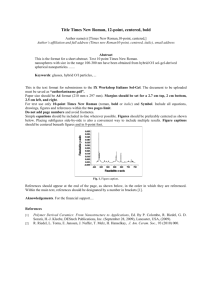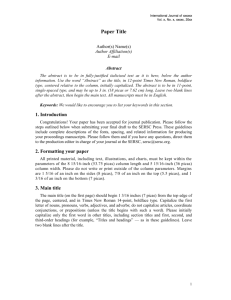Author Guidelines for ICTA Proceedings Manuscripts
advertisement
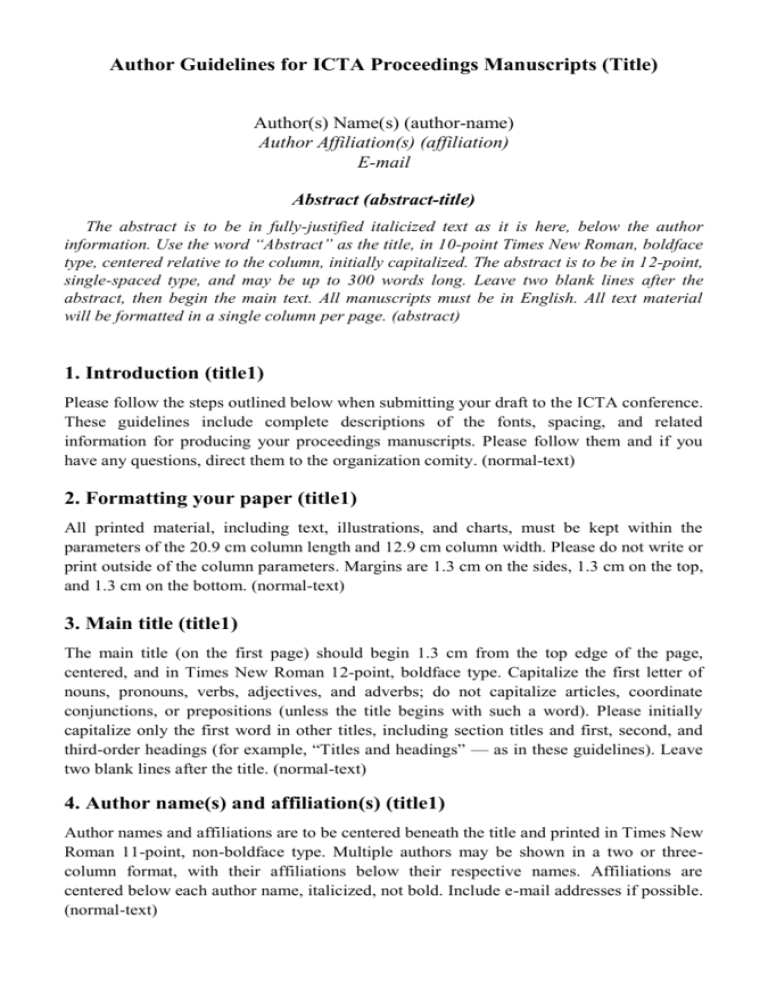
Author Guidelines for ICTA Proceedings Manuscripts (Title) Author(s) Name(s) (author-name) Author Affiliation(s) (affiliation) E-mail Abstract (abstract-title) The abstract is to be in fully-justified italicized text as it is here, below the author information. Use the word “Abstract” as the title, in 10-point Times New Roman, boldface type, centered relative to the column, initially capitalized. The abstract is to be in 12-point, single-spaced type, and may be up to 300 words long. Leave two blank lines after the abstract, then begin the main text. All manuscripts must be in English. All text material will be formatted in a single column per page. (abstract) 1. Introduction (title1) Please follow the steps outlined below when submitting your draft to the ICTA conference. These guidelines include complete descriptions of the fonts, spacing, and related information for producing your proceedings manuscripts. Please follow them and if you have any questions, direct them to the organization comity. (normal-text) 2. Formatting your paper (title1) All printed material, including text, illustrations, and charts, must be kept within the parameters of the 20.9 cm column length and 12.9 cm column width. Please do not write or print outside of the column parameters. Margins are 1.3 cm on the sides, 1.3 cm on the top, and 1.3 cm on the bottom. (normal-text) 3. Main title (title1) The main title (on the first page) should begin 1.3 cm from the top edge of the page, centered, and in Times New Roman 12-point, boldface type. Capitalize the first letter of nouns, pronouns, verbs, adjectives, and adverbs; do not capitalize articles, coordinate conjunctions, or prepositions (unless the title begins with such a word). Please initially capitalize only the first word in other titles, including section titles and first, second, and third-order headings (for example, “Titles and headings” — as in these guidelines). Leave two blank lines after the title. (normal-text) 4. Author name(s) and affiliation(s) (title1) Author names and affiliations are to be centered beneath the title and printed in Times New Roman 11-point, non-boldface type. Multiple authors may be shown in a two or threecolumn format, with their affiliations below their respective names. Affiliations are centered below each author name, italicized, not bold. Include e-mail addresses if possible. (normal-text) 5. Type-style and fonts (title1) Wherever Times New Roman is specified, Times Roman, or Times may be used. If neither is available on your word processor, please use the font closest in appearance to Times New Roman that you have access to. Please avoid using bit-mapped fonts if possible. True-Type 1 fonts are preferred. 6. Main text (title1) Type your main text in 10-point Times New Roman, single-spaced with 13-point interline spacing. Do not use double-spacing. Be sure your text is fully justified—that is, flush left and flush right. Please do not place any additional blank lines between paragraphs. Figure and table captions should be 10-point Helvetica non-boldface (or a similar sansserif font). Callouts should be 9-point Helvetica, non-boldface. Initially capitalize only the first word of each figure caption and table title. Figures and tables must be numbered separately. For example: “Figure 1. Database contexts ”, “Table 1. Input data ”. Figure captions are to be below the figures. Table titles are to be centered above the tables. 7. First-order headings (title1) For example, “1. Introduction”, should be Times New Roman 12-point boldface, initially capitalized, flush left, with one blank line before, and one blank line after. Use a period (“.”) after the heading number, not a colon. 7.1. Second-order headings (title2) As in this heading, they should be Times New Roman 10-point boldface, initially capitalized, flush left, with one blank line before, and one after. 7.1.1. Third-order headings: (title3) Third-order headings, as in this paragraph, are discouraged. However, if you must use them, use 10-point Times New Roman, boldface, initially capitalized, flush left, preceded by one blank line, followed by a colon and your text on the same line. 8. Footnotes Use footnotes sparingly (or not at all!) and place them at the bottom of the column on the page on which they are referenced. Use Times New Roman 9-point type, single-spaced with 10-point interlining spacing. To help your readers, avoid using footnotes altogether and include necessary peripheral observations in the text (within parentheses, if you prefer, as in this sentence). 9. References List and number all bibliographical references in 8-point Times New Roman, singlespaced with 10-point interlining spacing, at the end of your paper. When referenced in the text, enclose the citation number in square brackets, for example [1]. Where appropriate, include the name(s) of editors of referenced books. [1] A.B. Smith, C.D. Jones, and E.F. Roberts, “Article Title”, Journal, Publisher, Location, Date, pp. 1-10. [2] Jones, C.D., A.B. Smith, and E.F. Roberts, Book Title, Publisher, Location, Date. (references)
